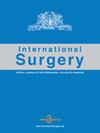胃切除术后排气管总淀粉酶值预测术后胰瘘
IF 0.2
4区 医学
Q4 SURGERY
引用次数: 0
摘要
目的:用腹腔引流液胆红素浓度与血清淀粉酶正常上限比值定义术后胰瘘(POPF)。然而,我们假设POD 3上的总淀粉酶值(AVD)可能对预测II级或更高严重POPF sPOPF更敏感,并比较了传统定义的POPF和AVD对sPOPF的预测能力。方法:对2011年10月至2013年2月间接受胃切除术的151例患者进行分析。所有病例均经右胃大网膜静脉残端及胰腺前方至吻合口后方放置引流管。在POD 1、3、5上测定排水量和排液中淀粉酶浓度。AVD由体积乘以淀粉酶浓度计算。结果:8例(5.3%)发生sPOPF。在单因素分析中,AVD和淀粉酶浓度比与sPOPF呈显著相关(P分别为0.002和0.007)。与POD 3上淀粉酶浓度比相比,POD 3上AVD的预测效果最好(曲线下面积0.876比0.844)。根据ROC曲线计算的截断值,AVD预测sPOPF的特异性高于淀粉酶浓度比(特异性:97.6% vs. 86.0%;PPV: 62.5% vs. 23.1%)。结论:与常规淀粉酶浓度比相比,POD 3上的AVD是预测sPOPF更具体的参数。本文章由计算机程序翻译,如有差异,请以英文原文为准。
Total Amylase Value in Drains After Gastrectomy for Predicting Postoperative Pancreatic Fistula
Objective: Postoperative pancreatic fistula (POPF) is defined using the ratio of the bilirubin concentration in abdominal drainage fluid to the upper normal range of serum amylase level. However, we hypothesized that the total amylase value in discharge (AVD) on POD 3 may be more sensitive for predicting grade II or higher severe POPF sPOPF, and compared the predictive power of the conventional definition of POPF and AVD for sPOPF. Methods: One hundred and fifty-one patients who underwent gastrectomy between October 2011 and February 2013 were analyzed. A drainage tube was placed in all the cases through the stump of the right gastroepiploic vein and the front of the pancreas to the back of the anastomotic site. The drainage volume and amylase concentration in the discharge were examined on POD 1, 3, and 5. AVD was calculated by multiplying the volume by the amylase concentration. Results: Eight patients (5.3%) developed sPOPF. In univariate analysis, both AVD and the amylase concentration ratio was significantly correlated with sPOPF (P = 0.002 and 0.007, respectively). AVD on POD 3 showed the best predictive performance compared with the amylase concentration ratio on POD 3 (area under the curve 0.876 vs. 0.844). Based on the cutoff values calculated from the ROC curves, AVD was more specific than amylase concentration ratio in predicting sPOPF (specificity: 97.6% vs. 86.0%; PPV: 62.5% vs. 23.1%). Conclusion: AVD on POD 3 is a more specific parameter than conventional amylase concentration ratio in predicting sPOPF.
求助全文
通过发布文献求助,成功后即可免费获取论文全文。
去求助
来源期刊

International surgery
医学-外科
CiteScore
0.30
自引率
0.00%
发文量
10
审稿时长
6-12 weeks
期刊介绍:
International Surgery is the Official Journal of the International College of Surgeons. International Surgery has been published since 1938 and has an important position in the global scientific and medical publishing field.
The Journal publishes only open access manuscripts. Advantages and benefits of open access publishing in International Surgery include:
-worldwide internet transmission
-prompt peer reviews
-timely publishing following peer review approved manuscripts
-even more timely worldwide transmissions of unedited peer review approved manuscripts (“online first”) prior to having copy edited manuscripts formally published.
Non-approved peer reviewed manuscript authors have the opportunity to update and improve manuscripts prior to again submitting for peer review.
 求助内容:
求助内容: 应助结果提醒方式:
应助结果提醒方式:


